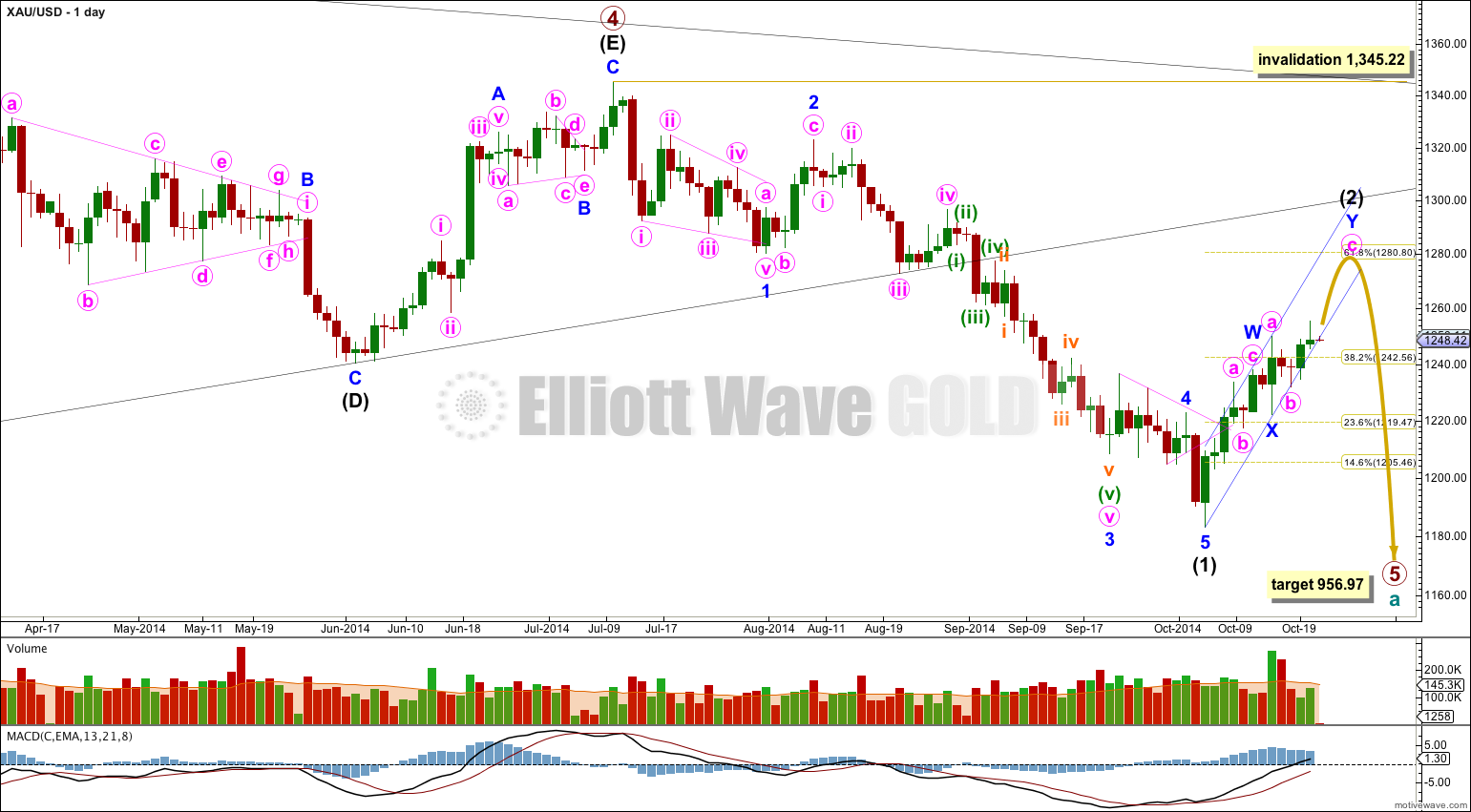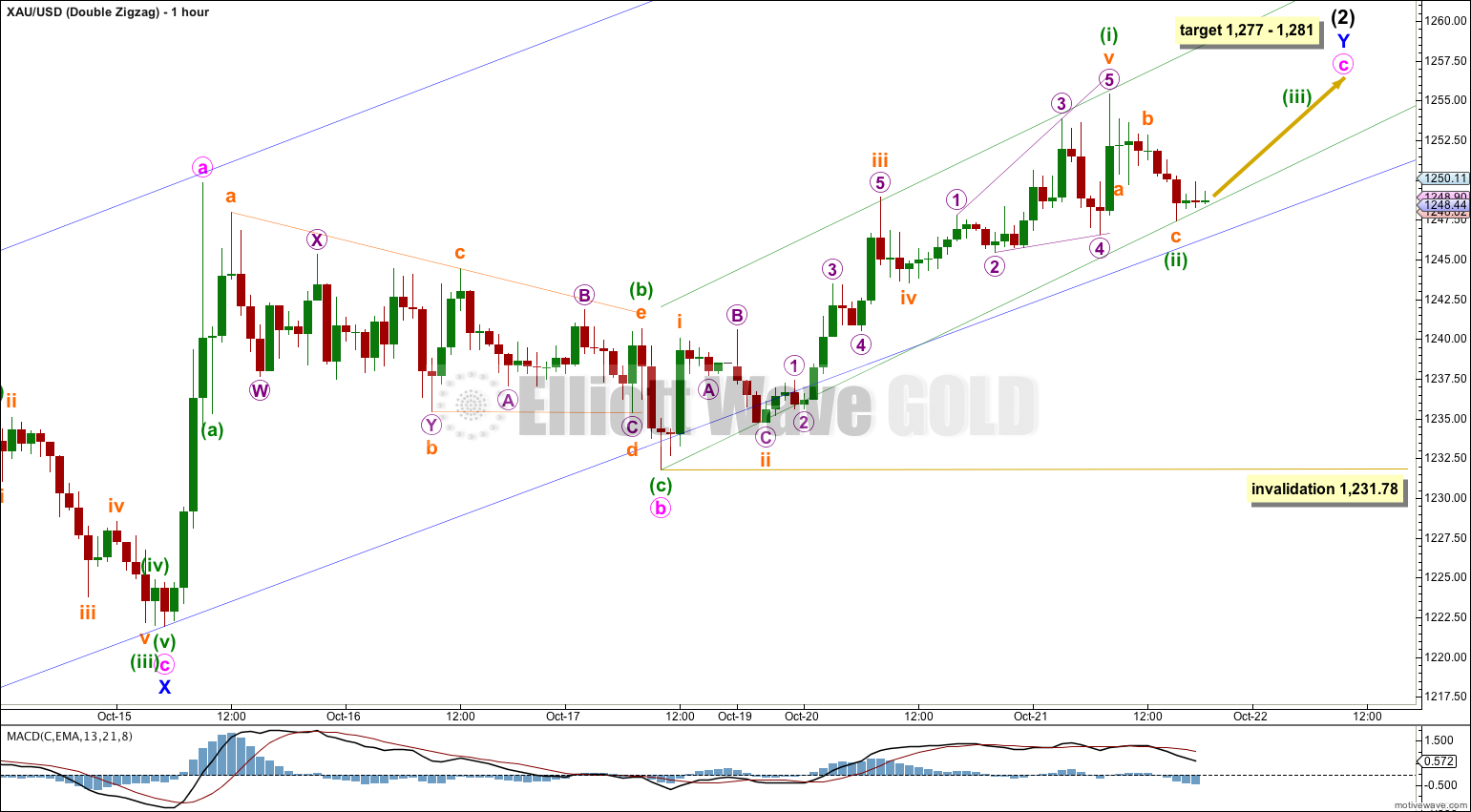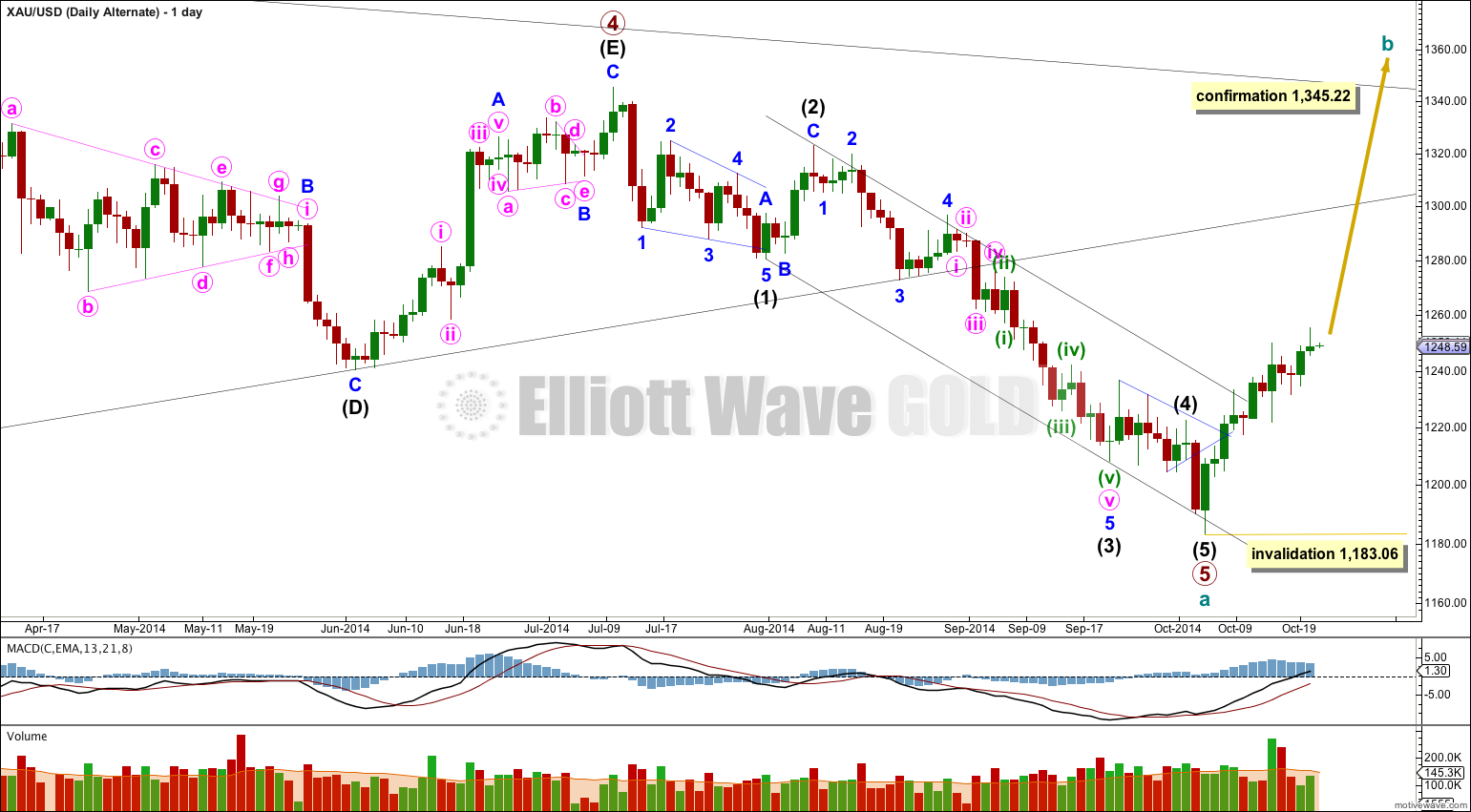Upwards movement continues as expected. The double zigzag structure is now the only Elliott wave count I have for you.
Summary: The target for upwards movement to end is a small zone: 1,277 – 1,281. It looks like the target may now be met in four more trading days.
Click on charts to enlarge.
Main Wave Count
On the weekly chart extend the triangle trend lines of primary wave 4 outwards. The point in time at which they cross over may be the point in time at which primary wave 5 ends. This does not always work, but it works often enough to look out for. It is a rough guideline only and not definitive. A trend line placed from the end of primary wave 4 to the target of primary wave 5 at this point in time shows primary wave 5 would take a total 26 weeks to reach that point, and that is what I will expect. Primary wave 5 is in its 15th week.
At 956.97 primary wave 5 would reach equality in length with primary wave 1. Primary wave 3 is $12.54 short of 1.618 the length of primary wave 1, and equality between primary waves 5 and 1 would give a perfect Elliott relationship for this downwards movement.
However, when triangles take their time and move close to the apex of the triangle, as primary wave 4 has, the movement following the triangle is often shorter and weaker than expected, and this is my main reason for presenting the alternate wave count to you. If the target at 956.97 is wrong it may be too low. In the first instance I expect it is extremely likely that primary wave 5 will move at least below the end of primary wave 3 at 1,180.40 to avoid a truncation. When intermediate waves (1) through to (4) within primary wave 5 are complete I will recalculate the target at intermediate degree because this would have a higher accuracy, and the target may move higher. I cannot do that yet; I can only calculate it at primary degree.
Movement comfortably below 1,180.84 would provide further confidence in this main wave count as at that stage an alternate idea which sees primary wave 4 as continuing as a barrier triangle would be invalidated. I am not publishing this alternate idea as a chart because it has an extremely low probability.
Draw a best fit channel about intermediate wave (2) on daily and hourly charts: draw the first trend line from the start of intermediate wave (2) to the low labeled minor wave X, then place a parallel copy on the high of minor wave W. I would expect intermediate wave (2) to remain within this channel. When this small channel is clearly breached by downwards movement with a full daily candlestick below it and not touching the lower trend line that shall provide trend channel confirmation that intermediate wave (2) is over and intermediate wave (3) should be underway.
Within intermediate wave (2) minor wave W lasted a Fibonacci 5 days. So far minor wave Y has lasted 4 days. If it completes in a further 4 days it will total a Fibonacci 8 days, and have a 1.618 duration of minor wave W.
Intermediate wave (2) may end close to a Fibonacci ratio of intermediate wave (1). Only because second waves are more commonly deep than shallow is the 0.618 ratio at 1,280.80 slightly favoured. But it does not have to be this deep.
At this stage I have only one hourly wave count for you. Upwards movement invalidated the flat correction idea for intermediate wave (2), and the overlapping within the last two days upwards movement does not fit for the single zigzag idea so I will discard it.
Intermediate wave (2) fits perfectly so far as a double zigzag which is incomplete. The first zigzag in the double is labeled minor wave W. The double is joined by a three in the opposite direction, an expanded flat labeled minor wave X which is shallow and typical of an X wave within a double zigzag.
The purpose of double zigzags is to deepen a correction when the first zigzag does not move price deep enough. Minor wave W fell slightly short of the 0.382 Fibonacci ratio.
Within the second zigzag in the double, labeled minor wave Y, minute wave c is incomplete. It must subdivide as a five wave structure, most likely a simple impulse and less likely and ending diagonal. At 1,277 minute wave c would reach 1.618 the length of minute wave a. This is just below the 0.618 Fibonacci ratio of intermediate wave (1) at 1,281.
Within minute wave c minuette wave (i) is now complete. Ratios within minuette wave (i) are: subminuette wave iii is 0.93 longer than 1.618 the length of subminuette wave i, and subminuette wave v has no Fibonacci ratio to either of subminuette waves i or iii.
Minuette wave (ii) is most likely to be complete even though it is shallow. It is a complete zigzag structure. It may be forced to be more shallow than a second wave correction normally is due to the support provided by the lower edge of the blue best fit channel.
I have drawn a base channel about minuette waves (i) and (ii). I would expect minuette wave (iii) to be likely to breach the upper edge of the channel. The lower edge of the channel may provide support for corrections along the way up.
I expect that if the target for intermediate wave (2) to end is correct then minuette wave (iii) may be shorter than minuette wave (i), and minuette wave (v) may be shorter still.
Because minuette wave (ii) does not show up on the daily chart as a red candlestick or a doji I will expect that minuette wave (iv) to come will also not show on the daily chart. I expect to see green candlesticks for the next four days to the target.
Minuette wave (iii) should show some increase in momentum beyond that seen for minuette wave (i).
If minuette wave (ii) does continue further (and if it does it would be a flat, combination or double zigzag) then it may not move below the start of minuette wave (i) at 1,231.78.
Alternate Wave Count
By simply moving the degree of labeling within primary wave 5 downwards all up one degree it is possible that primary wave 5 and so cycle wave a are over.
This wave count is reduced in probability by a small truncation. Primary wave 5 would be truncated by $2.66. The truncation is small though, so this wave count must be considered.
Movements out of triangles are often more brief and weak than expected, sometimes they are surprisingly brief. There is a nice example of what I mean by this here on the daily chart: after the triangle of intermediate wave (4) we saw a surprisingly quick short intermediate wave (5) down afterwards.
If price breaks out of the upper edge of the parallel channel about cycle wave a (look to the weekly chart for this channel) this would be first indication that this wave count is correct. This trend channel confirmation would come before price confirmation above 1,345.22.
The first movement upwards for cycle wave b should be a five wave structure. Within it no second wave correction may move beyond the start of its first wave below 1,183.06.
Movement above 1,345.22 would invalidate the main wave count and confirm this alternate.
At this stage upwards movement is not looking like an unfolding impulse because it is too choppy and overlapping, and so this alternate wave count is further reduced in probability.
This analysis is published about 07:52 p.m. EST.




That would see intermediate wave (2) as over already. It would have lasted only 11 days in comparison to intermediate wave (1) at 62 days, and it would be only 45% of intermediate wave (1).
So it would be too shallow and too brief.
I will have this idea as an alternate today though now, because that channel is so clearly breached. But it has a pretty low probability.
Dear Lara,
RE: ALTERNATE (although I’m in the Main camp)
“If price breaks out of the upper edge of the parallel channel about
cycle wave a (look to the weekly chart for this channel) this would be
first indication that this wave count is correct. This trend channel
confirmation would come before price confirmation above 1,345.22.”
Is the enclosed chart showing the correct channel you are talking about?
The information you’ve provided is so vital. Could you please post a chart for it? Thank you.
No.
I’m adding that channel back onto today’s daily chart.
To see how to draw it look at the weekly chart here:
http://elliottwavegold.com/2014/09/gold-elliott-wave-technical-analysis-12th-september-2014/
Hi Lara,
can ask you why you said this: “Within the second zigzag in the double, labeled minor wave Y, minute wave c is incomplete” ? Why you do not consider that minute wave c would be completed ?
Thanks in advance.